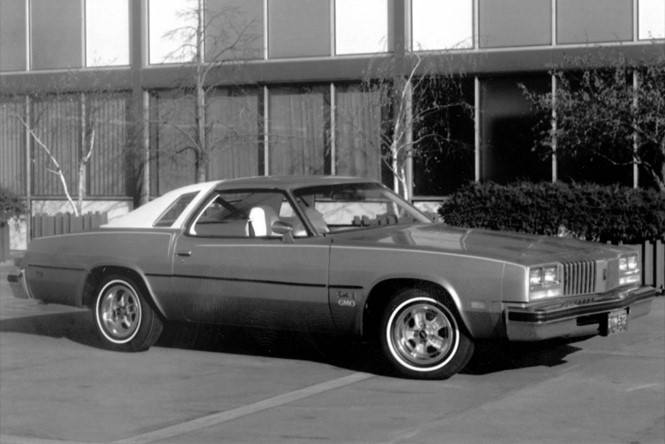Rewind: Oldsmobile

Could a rebrand or brand development strategy have saved GM’s Oldsmobile automotive brand? How?
Mark Meghezzi, proposition manager at Telefónica UK
Oldsmobile found itself in a rapidly squeezed middle. As GM sought to simplify its brand portfolio, the Oldsmobile brand lost exposure and relevance – seen as the poor relation to Buick and Chevrolet and little more than a testbed for new technologies.
The opportunity for Oldsmobile at this point – the late ’90s/early ’00s – was to recreate itself as a boutique brand. With a rich heritage of power (pioneering the V8 engine), quality (442 muscle car) and brand, Oldsmobile could have carved out a strong niche in the medium-high end of car collectors and power/muscle car fans.
Ultimately, GM chose to use Chevrolet to win in this market. But, given its current performance, there’s nothing to say that Oldsmobile wouldn’t have been an even better choice.
Piers Guilar, executive strategy director at FITCH EMEA
For young consumers today, the name Oldsmobile is more likely to conjure up images of Nokia brick phones than American muscle cars. Yet Oldsmobile were once one of the biggest automotive brands in America.
Despite starting in 1897, Oldsmobile really built its brand in the '50s producing big, beautiful, powerful cars iconic of the era. Even the first rock n’ roll song, from Ike Turner, took its title from an Oldsmobile model, the ‘Rocket '88’.
By the early '80s Oldsmobile was the third best-selling car brand in the US, but demand outstripped GM's production capacity of the Rocket V8, Oldsmobile’s famed muscle engine. Keen not to lose sales, GM decided to use their own less powerful engines, without telling the customers.
While other factors affected the business, including the rise of domestic manufacturing costs and cheaper Japanese imports, customers were misled and trust in the Oldsmobile brand started to erode.
Rather than reposition the Oldsmobile brand to remain relevant to consumers and distinctive from imports, Oldsmobile’s strategy was to mimic them, launching the Aurora in the '90s, the car that ultimately killed the brand.
The Aurora was everything that Oldsmobile was not. Even the adverts talked about “not your father’s Oldsmobile”. They were right on that front, the car had been de-badged, de-branded and de-positioned. The last traces of the iconic American brand had been removed and replaced with blandness.
When it was phased out in '04, Oldsmobile was the oldest US automobile brand, but its cars had lost the distinctive qualities associated with the marque. Downplaying the brand only hasted its decline. A re-brand might not have saved it but a de-brand certainly killed it faster.
Simon Cotterrell, owner at Goosebumps brand consultancy
No. As the old adage goes, ‘You can have a great product with a lousy brand, but you can’t have a great brand without a great product.’ From the little I know about Oldsmobile and GM during the ’90s and early ’00s, great products were thin on the ground, and where breakthroughs in technology and design were being made, Oldsmobile was the last brand in its burgeoning portfolio to take fresh thinking to market.
A new logo, a lick of paint and perhaps a repositioning back to the grey market heartland GM seemed recklessly committed to move away from, might have nudged the sales and the consideration stats a little to the right, but without a product overhaul, impending doom was inevitable.
But, there is a ‘but.’ If you’re from the Apple school of thought, where product development cycles are created to fall in with brand strategy, maybe, just maybe, the answer might have been ‘yes.’
So often brand is used as a retrospective garnish to a product, dressing-up a limp main course with some colour and posh ingredients. But make the brand the prime-cut and then see what happens.
With razor-sharp positioning, brands don’t just have the ability to direct comms, but every aspect of product and service development. It would have required significant investment from GM to reverse its logic in this way, but knowing where you need to go doesn’t half give you a head-start in getting there.
Julie Springer, CMO at TransUnion
While I’m not a car marketer, I cannot help but think that some basic brand marketing tenants might have been applied to help GM maintain its once-massive share, and potentially keep the venerable Oldsmobile brand alive.
With a brand over 100-years old, it’s difficult to rebrand entirely. And, since the reality is that the brand is truly owned by the consumer – unless the consumer felt the change, you can’t just tell them so.
Case in point, Olds’ '80s ad campaign, 'This is not your father’s Oldsmobile.' Well, guess what? They were right. My father’s Olds would have been cool back in the day. The mid-’80s version? Not so much.
How could GM have done it differently?
Differentiation: we are all faced with centralising processes as we reach scale, but not at the expense of everything that makes us special and unique. GM put Oldsmobile on a highly efficient assembly line of extinction.
Core values: GM abandoned the core brand value of innovation. There was no longer a reason to buy an Olds. Had it perhaps considered fewer models and having one or two that really delivered on innovation, it may have succeeded.
Aspiration not transformation: don’t try to aspire to too much brand transformation at once. You can usually nudge the brand along, but you cannot abruptly do a U-turn. From 100 years of innovation to ‘the Honda alternative’ is too big a departure.
It’s easy to be the back-seat driver on this, and I’m positive GM didn’t want Olds to fail. Now we can look to it as a cautionary tale and use the lessons to learn for our own purposes.


